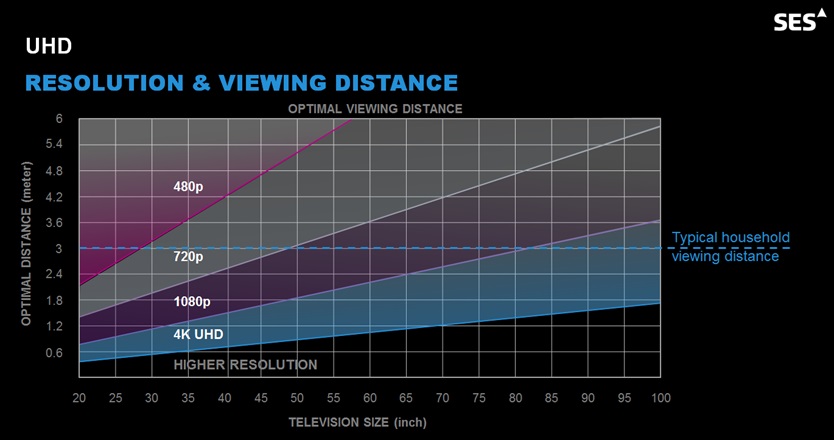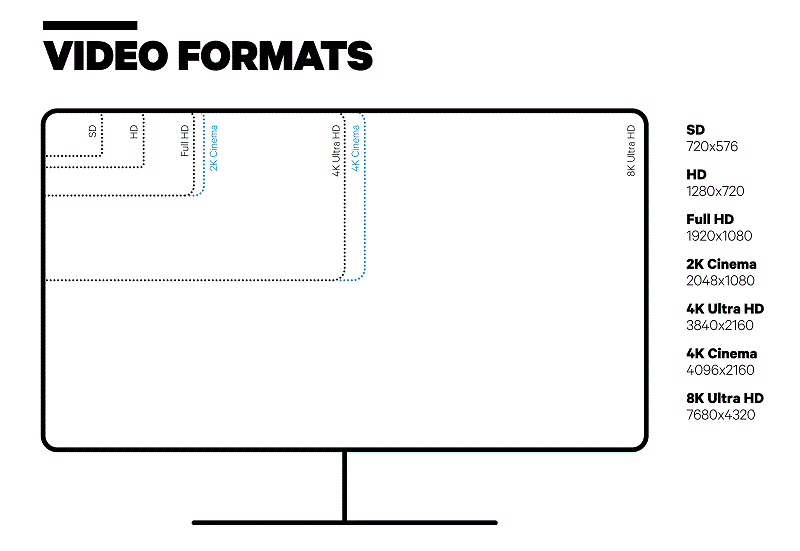When you take a picture with your high-resolution smartphone or your digital SLR, it looks okay on-screen, but not quite the way it did when you viewed it in real life. Something about the way the light falls, the detailed edges, the saturation of colour… it’s just never as real-looking on a screen.
As image quality has improved from SD to HD to 4K Ultra HD, it has gotten closer to that “realness” that we see, or that we imagine in our mind’s eye. How real an image looks relies on viewing distance, but also on resolution, frame rate, colour depth, colour gamut, and brightness. 8K gets us even closer to an image that feels as real as life—particularly when we know the ideal viewing angle, distance, and screen sizes.
Resolution counts
Turn on your 4K Ultra HD TV screen today, and you see a pretty incredible picture. At a resolution of 3840 × 2160, and 8 million pixels, the image is convincingly detailed, and far better than the images of the past.
Now, imagine a resolution of 7680 × 4320 and 33 million pixels—4 times the area of the current 4K Ultra HD screen. Pair that with screens boasting more than 1 billion colours, and the picture suddenly becomes more alive, more immersive, and far more real.
The current frame rate of 60Hz is relatively smooth. Moving to 100-120Hz in 8K will virtually eliminate any blur—even with the fastest live-action movement. The smooth movement and highly detailed image will have viewers feeling like they are right there watching a concert or big game live.
Getting up close
Remember the days of oversized backlit television screens that required a large, dedicated entertainment space? Sitting too close would result in a picture that was twitchy and unclear, and a challenge to watch. The improvements in resolution, refresh rate, and picture quality have caused television screens to steadily grow in size. Larger screen sizes and 8K programming will provide consumers with an even more immersive experience.

With 8K, the colour volume and density of the picture increase its texture, which has an impact on the ideal viewing distance. If you sit too close to your 4K Ultra HD TV, you will start to see pixels, and the context of the content becomes distorted. The ideal viewing distance for 4K Ultra HD is 1.5 times the height of the screen.
With 8K, the viewing distance would reduce to 0.75 times the height of the screen applying the same metrics. However, industry experts claim that for the most “real” experience, the ideal viewing distance will be 1.2-1.5 times the screen height. This viewing distance leverages the colour volume and pixel density to create an image our brains interpret as more. At this distance, you aren’t just able to view all the content correctly—the content feels more immersive. This immersive feeling is maximised on 8K screens of 80 inches or more.
On these much larger 8K screens, the viewing angle is 100º—letting viewers see the whole picture from any spot in the room. Yet, if you want the “realness” of the picture and to be fully immersed in the content, Toshiyuki Ogura, Chief Distinguished Engineer at SONY, says the brain will experience true picture “realness” at a viewing angle of 60º and distance of 1.5 times the screen height.
Seeing the bigger picture
Filming in 8K has some incredible advantages. When we filmed our “Mastering the Details” videos, there were many things filming in 8K had us thinking about differently, aside from the dramatic difference in picture quality.
The content is deeper, richer, and more immersive. While the consumer will appreciate this level of detail, they won’t see the real difference until they view it on a larger screen. Since filming in 8K is a wider shot, it adds new challenges and new dimensions, bringing more of the picture to life.
One of the greatest challenges is that content that is poorly lit is just as detailed as the lit content. Working in such fine detail exposes the shots that don’t work, too, something for which content creators will have to find new creative solutions. Capturing video at such a high resolution also means the file sizes are massive, which creates challenges in the editing suite. The technologies around creating video—beyond merely capturing the image—are still catching up to the small number of 8K cameras available on the market.
Getting ready for 8K
Since our eyes don’t have the visual acuity to see the difference on smaller screens, future screens of 80 inches or more will show a much richer image in true 8K Ultra HD. TV manufacturers are working on technology that uses light-emitting diodes (LEDs) directly, rather than shining LEDs through liquid crystal displays. This will allow the creation of screens that take up an entire wall, and maximise the qualities of 8K video. The journey to bring the best content to the viewer means it’s more than just seeing the picture—it’s about creating a more emotive and truly immersive experience for consumers.
Fast 8K facts:
- The 8K screen resolution is 76803840, which is four times the area of 4K
- New screens have more than 1 billion colours—and more colours will show with higher frame rates of 100-120Hz
- The bandwidth requirements to transfer 8K video are high—consumers would need a 90cm antenna rather than a 60cm antenna for satellite broadcast, and 8K video would overload terrestrial networks
- The latest generation video CODEC transfers at 20Mbps—8K requires 80Mbps
- With cable and IPTV, you need to be in close proximity to the exchange with hefty bandwidth capabilities to receive 4K—satellite will be the best infrastructure for the delivery of 8K video content
Related Content
| View the Ultra HD page | |
| Download the Ultra HD eBook |






